12 string guitar tuned to 5ths
|
I have thought for a long time that 12 string guitars are as boring as the New Seekers, Ledbelly etc. Ungainly things that many a novice goes "ooh, that must be difficult to play" thinking that because it has 12 strings that the player must consider each and every string individually.
Not true. They are built for strummers and gear junkies like myself who are thinking of thickening out their sound with the addition of the octave strings, which happily for most people can be forgotten about in the ensuing wall of (usually) out of tune sound.
However having recently bought this beautiful Taylor 12 string...
|
|
|
...I have made some startling discoveries.
|
The novices could be right after all. These things can be made far more interesting and hence difficult to play - actually like a real instrument rather than a bluffers prop.
Instead of the usual four octave doubles and two unison doubles, string it with all six double strings tuned a 5th apart. Now this is all OK until you try tuning the top double to E and the B(!) above it. Take it from me, strings which are guitar length are not capable of going that high without breaking.
Therefore the solution is to detune the entire guitar a tone and a half so that B becomes a G#. This means you then have to get slightly thicker bass strings to compensate. I have tried many permutations and after a lot of experimenting the tunings and string gauges I ended up with (for now!) are as follows:
|
|
string
|
1
|
2
|
3
|
4
|
5
|
6
|
7
|
8
|
9
|
10
|
11
|
12
|
|
tuning
|
C#
|
G#
|
G#
|
D#
|
E
|
B
|
B
|
F#
|
F#
|
C#
|
C#
|
G#
|
string gauge
|
13
|
9
|
17
|
12
|
28
|
16
|
38
|
23
|
44
|
30
|
56
|
40
|
|
So get that old neglected 12 string out from under the stairs and try this. The chords are truly beautiful and totally unreachable with a standard guitar. If you want to take it further - a bit of finger picking involving the thumb produces some wondrous and unexpected tunes.
I have long been a fan of guitars using this 5th harmony, but up until now I have had to produce the effect electronically using a guitar synth or by persuading Boo into playing the identical part to me a 5th lower.
I have written several songs I am very proud of in this way, but I have been inspired all over again by the 12 - and what's more there's no electronic jiggery pokery, which makes it totally folk club friendly!
Here are a couple of videos of the tunes where I used the 5th tuned 12 string:
|
|
|
Fingerpicks
|
Most people who try using fingerpicks do so in a desperate effort to find a way round the weak fingernail problem. They quickly give up because fingerpicks feel cumbersome at first. But please... PERSEVERE!
Firstly, don't put them on the wrong way round! They go the opposite side to your fingernails. If you wear them like false fingernails, they'll just get pulled off.
|
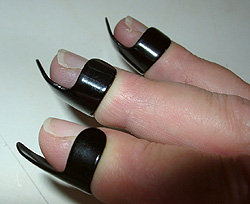
|
I have used fingerpicks but no thumb pick (see below!) more or less since I started playing and I don't find it a problem. In fact I would even say a certain degree of peace has been achieved having sorted out the fingernail problem years ago!
Firstly - experiment with different types until you find ones which are comfortable, the right size and the right angle. There are LOADS of different shapes and sizes.
Secondly - use plastic ones. They are quieter and if they are too tight or the wrong shape, they can be modified by dipping them in boiling water and then bending them.
Finally - you've got to give them a chance. Use them for a month and you'll be surprised how quickly you'll forget you're wearing them.
|
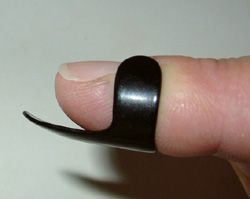
|
I use black Gibson picks which are a basic shape with no gimmicks. The ones on my 2nd and 3rd fingers are identical and fairly standard. However my 1st finger pick (pictured above) is a slightly different shape and I have modified it further - bending it almost straight using boiling water, so that it is much flatter than the others.
This means I can use it like a plectrum occasionally - holding it between thumb and 1st finger to enable plectrum-like downstrokes.
|
|
|
Thumb picks or thumb nails?
I have only ever used a thumb pick on my banjo and I have never needed one for guitar as my thumb nail almost never gets worn down enough to inhibit my playing. However I have to be very careful about the length of my picking thumb nail, because if it's a little too long I find I'm often levering up the bass strings and slapping them against the fret board unintentionally instead of just making a clear connection. By the way... you can still slap them down if you want to!
Of course many people (including my hero Bert Jansch) used a thumb pick and fingernails only, which is the opposite way round to me and which works for a lot of people.
|
|
|
Boiling strings
|
String boiling has been a favourite pastime of mine since I started playing. It saves you a lot of money if you get those knackered old roundwound nickel strings (guitar or bass variety) and simmer them gently in plain old boiling water with no additives. This gets all the sweat and dirt out from between the windings and makes them sound like new!
After a couple of hours dry them off thoroughly and get playing! Repeat this process over and over. (Eventually the strings will break from metal fatigue but the tone will always come back after a good boil!)
N.B. This only works on nickel strings and not on bronze, which will only turn green and mouldy! So as most acoustic players these days use bronze, this is a totally worthless piece of advice for folkies. However if you do sweaty gigs with an electric, I hope this is helpful. Oh - take them off the guitar first.
|
|
|
Strings sticking in nut
|
This can cause tuning problems when the unwound topstring doesn't run smoothly through its groove in the nut (the white string guide at the head end of the fretboard).
Also if you're into bending harmonics below the nut as I am, they can stay where you bend them - not the desired effect!
My pal from eons ago Gordon Giltrap (who has been known to bend a harmonic or two in his time) told me his solution to this problem:
Take the string out of its notch and just get an ordinary pencil and scrape some graphite into the groove.
End of problem.
|
|
|
Dry fretboards
|
If you're a sweaty person particularly, the fretboard wood tends to dry out over time and the grain starts to open up. The dry air of central heating can also have an effect.
Every year or two give your guitar a treat and rub some linseed oil into the fretboard, leave overnight, then wipe it down with some polish the next day and although your guitar will stink like a howitzer for about a week, the wood will be supple again, the grain will close up and it will feel smooth and sexy to play on.
|
|
|
Truss rod adjustment
|
The truss rod is a strengthening rod that runs through the guitar neck and can be adjusted by either a truss rod spanner or an allen key at one end of the neck or the other. The favourite place (on most guitars including Gibsons) is underneath the small plate on the headstock, or (on Martins) inside the soundhole, or (on Fenders) through a hole in the plate which secures the neck.
Wooden necks will move with the temperature and if you have your action as low as possible like I do, it will get lower still when the temperature rises. So when summer arrives, try loosening the truss rod an eighth turn or so. Your action will then return to where it was. Similarly in the winter; if your action seems high all of a sudden, just tighten the truss rod a little to cure the problem. I remember which way I probably need to turn the truss rod by thinking of it as loosening your shirt tie knot in warm weather and tightening it again in cold!
You can check your truss rod visually by looking along the side of the neck. The neck should be straight from the body but with a very slight bow around the 7th fret. This allows the strings to vibrate without rattling. You can also check whether you've got this slight bow right by fretting any of the strings from the 12th fret downwards and seeing if they produce a quiet but clear note on the nut side of the fretted string i.e. the non sounding hole side. If you're not getting higher and higher notes as you fret from the 12th downwards then you need to loosen the truss rod slightly. Do that in very small increments and keep checking until you hear those very quiet notes sounding on the 'wrong' side of the fretted note.
|
|
|
Tuning by ear to standard
|
There are many ways to tune a guitar to standard tuning - EADGBE.
The most common is simply fretting a string and comparing it to its neighbour.
You can also use 5th and 7th fret harmonics to compare neighbouring strings - this is OK until you get to the G string when you want to compare it with the B string. Suddenly you find the harmonics are inconveniently not the same note and so you have to resort to fretting the string again.
|
My own quick way of checking is to use this chord, which you may notice only has 2 notes in it, but each note is duplicated in other octaves. Fifths and octaves are easier to check than most of the other intervals - and this is all this chord has.
|
 |
|
|
Creative in standard tuning
|
This idea may seem obvious to a trained musician, but if you've picked up guitar playing by ear as most of us have and been trying to write songs, then this may help...
Read my bit about different tunings and you can understand how I came to depend on them heavily for finding new guitar based ideas for songs and instrumentals. I would never dream of using standard tuning to find anything creative. However, having played in bands, I discovered that using different tunings live is impractical unless you have extra guitars ready and waiting. Also songs in strange tunings usually become set pieces with not much room for experiment once written.
Therefore I have been forced into playing in standard tuning (EADGBE) nearly all the time these days. This has the advantage of providing reference points and knowing what to play and how to play it particularly when you play with other people. Unfortunately you are still stuck with these reference points when you're tring to write something and consequently the paths can appear to be much too well trodden.
Unless you are aiming to be commercial (ugh!), or only in it for a good pose (tee hee!), you end up sick to death of your own cliches. A friend of mine wrote a song on this very subject called 'While My Guitar Gently Groans!' But if you want to be truly creative in standard tuning, you obviously can't rely on any surprises from a self induced lack of knowledge brought about by tuning the guitar differently.
You therefore have to create your own interest.
I have managed to do that by playing the usual thing I always play that I can't stand. I then start again and investigate where it is that my ears start to go to sleep out of boredom. I then refuse to let my hands do their usual thing and I make the tune/notes go somewhere my ears are not expecting. Same as using a tuning to surprise the songwriter in you, but waking your imagination to achieve the same effect. The main thing is not to go to sleep when you're investigating a tune or you'll revert to old tried and mistrusted ways!
Don't think that just because you're actually playing that you're actually doing anything creative. Guitar playing can be just a nervous habit! Stay aware and before you know it you should be able to get something going and maybe have the basis of a new song.
It's easier done than said! Try it! It works for me!
|
|
|
Endless choice
|
I think endless choice is a real killer,whether you're talking about equipment, creativity or come to think of it... just about anything! We come to believe that freedom is everything, so the more choices you have the better. Not so!
I think you've got to have a framework or some limits to work within, in order to get to know something. If you can do anything, it's hard to do anything.
Many people who have a recording set up, also have a phobia about turning it all on - not because of lack of inspiration, but because of the problem of capturing any inspiration that's present without getting your head fucked by the technology. Keep it simple and understandable. Hang on to those old machines that you can use easily.
I used to have one of the old guitar synths which made a basic sound which you could alter the tone and pitch of - and that was about it. I wrote loads of songs on it (which I am still quite proud of!) until its basic hoovering noise was superceded by the much cleverer midi guitar synths, with which you could access any sound. The result? No more songs and I stopped playing guitar synths.
I really don't want to be in the position of having to choose endlessly just cos I can! It's back to the old question "Why does a dog lick its own bollocks?"...
|
|
|
Click can help overuse of rals (slowing downs)
|
Most of the time, I would say that unless you want to use the quantizing power of a computer sequence then steer clear of using a click track or metronome for acoustic music particularly.
However, there are times when it helps.
Once I just couldn't get a song sounding right and I think the problem was that I felt a bit precious about it. The song was fairly slow and had lots of rals (slowing downs) in it and I was really making a meal of them. It just kind of made you feel seasick when you heard it back, so I experimentally programmed a click which slowed down only a couple of essential times rather than at the end of every line.
Although at first I felt like I was being dragged through the song without expression, the end result was fantastic. I discovered that the effect of the rals could be achieved using dynamics rather than tempo, and the song ended up sounding exactly like I thought it should.
|
|
|
Click breakthrough
|
If you have a really quiet part of a song and you have used a click, sometimes the sound of the click can be heard coming from the headphones of the artist and onto the recording.
This is not only because the click might have been too loud, but also because it might have been a sound that is too noisy. Cow bells used to be a favourite and used to cut through everything (which is bad news unless you're recording Honky Tonk Women!) Built in metronomes can be equally intrusive making horrible beeping noises that can be heard much too easily outside the cans.
I program a closed hi hat as a click (usually four to the bar). It is a very light sound and I've never ever heard it come through onto a track no matter how quiet it gets.
|
|
|
Banjo mutes
|
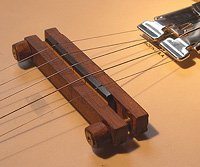 The mute doesn't just make the banjo quieter for practising, it also creates a very interesting tone. It takes the attack out of the banjo sound, gets rid of the oink, and leaves you with an almost guitar like sustained sound. The mute doesn't just make the banjo quieter for practising, it also creates a very interesting tone. It takes the attack out of the banjo sound, gets rid of the oink, and leaves you with an almost guitar like sustained sound.
I made this one myself when I remembered a long time ago using a violin mute on a ukelele when my parents were being driven mad by my George Formby impersonation. My mute is made of two bits of hardwood which screw up tight either side of the bridge under the strings.
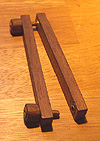 I have since discovered you can buy banjo mutes on the internet. However most of them look like they suffer from the same problem - they will probably hinder your right hand by sticking up above the bridge. I have since discovered you can buy banjo mutes on the internet. However most of them look like they suffer from the same problem - they will probably hinder your right hand by sticking up above the bridge.
Here's a link to a commercially available one which looks OK. There are also some inventive suggestions on the web such as using one of those elastic capos wrapped round the bridge under the strings as a mute.
It's surprising. Check it out...
|
|
|
|
Lazy guitar playing
|
Have you noticed that whenever someone plays a chord of D, they have to do that pull off to the open E or do a twiddle. This is a prime example of what nearly all guitar players do, which is to go for the easy option. Add to that the regular use of comfortable shapes and you might understand what I mean by lazy guitar playing. Don't get me wrong, that is part of what makes the guitar so accessible but it's also what limits it. Ever heard anyone doing that D twiddle in E? Probably not - because there aren't any handy open strings. You might still want to hear that though if you're a writing something. What do you do? Most people (myself included) will find something similar that's more comfortable that will do the job. It wasn't what you heard though was it?
I have spent a long time lately transferring my own songs onto six string from my 5th tuned 12 string (read the whole story here) and it has taught me something in this department. Because the more interesting notes were relatively easy to reach on this weirdly tuned instrument, I used them with glee. Then, while trying to work them out on six string, I was surprised to find that nearly all the voicings and weird notes were reachable with a bit more effort - and that's an effort I wouldn't normally have made.
My ears were very happy with the result and I now have some very interesting songs for six string that wouldn't have come about without this tortuous process! It all made me re-think my attitude a bit and try and satisfy my ears and ignore my aching fingers (they stop aching after a while!)
|
|
|
Sounding natural using a click
|
One of the hardest things to do when you're recording is playing naturally when using a click track. You might be using a click track for a variety of reasons e.g. evening out the tempo, using quantized percussion etc, but getting the important instruments to sound coherent while you're glued to a very uninspiring metronome can be well nigh impossible.
My answer to the problem is to record the first instrument using only the click. Treat this as a guide recording, not as any finished thing. Then record your second instrument or vocal with the click and the first instrument. Treat this also as a guide instrument and then replace the first one. Keep replacing one and then the other until it sychronizes and sounds like you want it to sound. Continue this ping pong process as long as it takes to make the track sound even and natural.
The thing to be aware of is that this technique will probably sound terrible for a couple of passes, but it will steadily improve until you gradually hear what you want to hear. The idea is that each time you record you will be guided by an instrument which has an increasingly better feel and which is more synchronized than the last.
It is a drawn out process but not as drawn out as doing 56 crap takes, thinking you're useless and giving up!
|
|
|
|
|
|
|
|



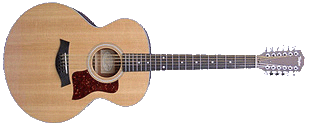
 The mute doesn't just make the banjo quieter for practising, it also creates a very interesting tone. It takes the attack out of the banjo sound, gets rid of the oink, and leaves you with an almost guitar like sustained sound.
The mute doesn't just make the banjo quieter for practising, it also creates a very interesting tone. It takes the attack out of the banjo sound, gets rid of the oink, and leaves you with an almost guitar like sustained sound. I have since discovered you can buy banjo mutes on the internet. However most of them look like they suffer from the same problem - they will probably hinder your right hand by sticking up above the bridge.
I have since discovered you can buy banjo mutes on the internet. However most of them look like they suffer from the same problem - they will probably hinder your right hand by sticking up above the bridge.